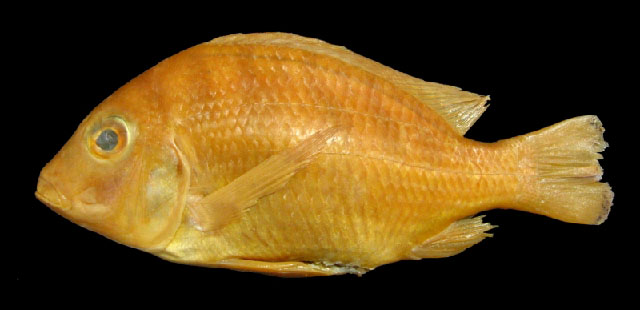| Cichlidae (Cichlids), subfamily: Pseudocrenilabrinae |
| 27.6 cm NG (male/unsexed) |
|
benthopelagic; freshwater, |
| Africa: middle and upper Congo River basin, including the Sankuru, Sangha, Ubangui, Uele, Kotto, Bomu, Lomami, Aruwimi, Itimbiri, Lindi-Tshopo, Lualaba, upper Lualaba and Chambezi, in Cameroon, Central African Republic, Democratic Republic of the Congo and Zambia (Ref. 52346). Also reported from the Sanga in Republic of Congo (Ref. 44840). |
|
Dorsal spines (total): 14-16; Dorsal soft rays (total): 11-16; Anal spines: 3-3; Anal soft rays: 7-8; Vertebrae: 28-29. Diagnosis: 33-35 lateral line scales; 15-16 gill-rakers along lower limb of first arch; entire premaxillary oral valve present; dorsal fin length of 55.4-65.5% SL (Ref. 52346).
Description: relatively deep bodied and robust; predorsal profile more or less straight, rising at an angle of about 50-60° to the horizontal; fleshy bulge in interorbital region frequently present; snout length variable: some specimens with a straight-snouted appearance, others with a shorter snout, a somewhat inclined lower jaw and a definitely pugnacious aspect; dorsum variously recurved from nape to caudal peduncle; deepest body depth may be at dorsal fin origin, or as far back as below 5th-6th spine; mouth a little inclined from the horizontal when closed, but inclination rarely strongly marked, except in certain deep bodied, short-snouted individuals from the Luvua River with a quite steeply inclined lower jaw, often at an angle of about 15-20° to the horizontal; lips thick and reasonably fleshy; lower pharyngeal jaw mostly robust and well ossified; inferior vertebral apophysis well developed and robust, and of standard Tylochromis type; broad, crenate gill-rakers closely overlapping for length of lower limb of first arch; 2-3 short hypobranchial rakers usually present; short and thick epibranchial rakers fringe upper limb of first arch; 33-35 lateral line scales (Ref. 52346). 7-8 scales below lower lateral line; 3 scale rows on cheek below eye (Ref. 42005). Upper branch of lateral line usually terminates a little in advance of end of dorsal fin, but may extend full length of fin; terminal canal bearing scales often descend a scale row, canal then continuing for another 2(-3) scales; dorsal and ventral branches of lateral line on caudal fin well developed and extending almost to fin periphery; median branch usually well developed, but rarely extending much beyond 2/3 of caudal fin length; dorsal fin spines increase gradually in length to (5th) 6th-7th and are then more or less equal in length; anal fin rounded; pectoral fins rather short, rarely reaching beyond level of vent; first branched pelvic ray somewhat produced but rarely markedly filamentous; caudal fin slightly emarginate and usually heavily scaled almost to fin periphery (Ref. 52346). Coloration: pearl grey and greenish above in more or less longitudinal stripes, whitish below, silvery troughout; scales of caudal peduncle and flank in larger individuals ringed in dark brown pigment, resulting in a series of longitudinal striations passing along scale rows; longitudinal striping most pronounced on caudal peduncle and dorsum; vertical stripes less prominent in adults and completely absent in specimens of 15cm SL (Ref. 52346). Dorsal fin transparent grey with bright blue reflections on spines and brownish-red longitudinal markings; caudal fin greyish edged with red on lower half (Ref. 52307, 52346). Pectoral fins transparent grey; pelvic and anal fins pale blue-grey (Ref. 52307, 52346), former with red markings anteriorly (Ref. 52346). Anal fin of mature male fish smoky brown with a few rows of pale non-ocellate maculae that are typically lacking in females; mature males exhibit caudal fin striping and spotting; top of head in front of eyes dark grey; gill covers yellowish and an area behind head dusky yellowish grey; some red markings between pelvic and pectoral fins (Ref. 52346). Preserved juveniles: strong nape stripe separated from dark opercular blotch; 7-8 thick vertical strips which extend down onto flank well below midline, often almost to ventrum; juvenile barring usually pronounced in specimens of less than 6-7cm SL; dorsal fin dark grey brown and spotted with numerous rows of non-ocellate pale maculae (Ref. 52346). |
| Opportunistic benthic macrophage (Ref. 52346). Feeds on plants, insects and (to a lesser degree) molluscs (Ref. 52307). Maternal (Ref. 52307) mouthbrooder (Ref. 4910, 52307) that does not pair-bond (Ref. 52307). |
|
Least Concern (LC); Date assessed: 16 February 2009 Ref. (130435)
|
| harmless |
Source and more info: www.fishbase.org. For personal, classroom, and other internal use only. Not for publication.

